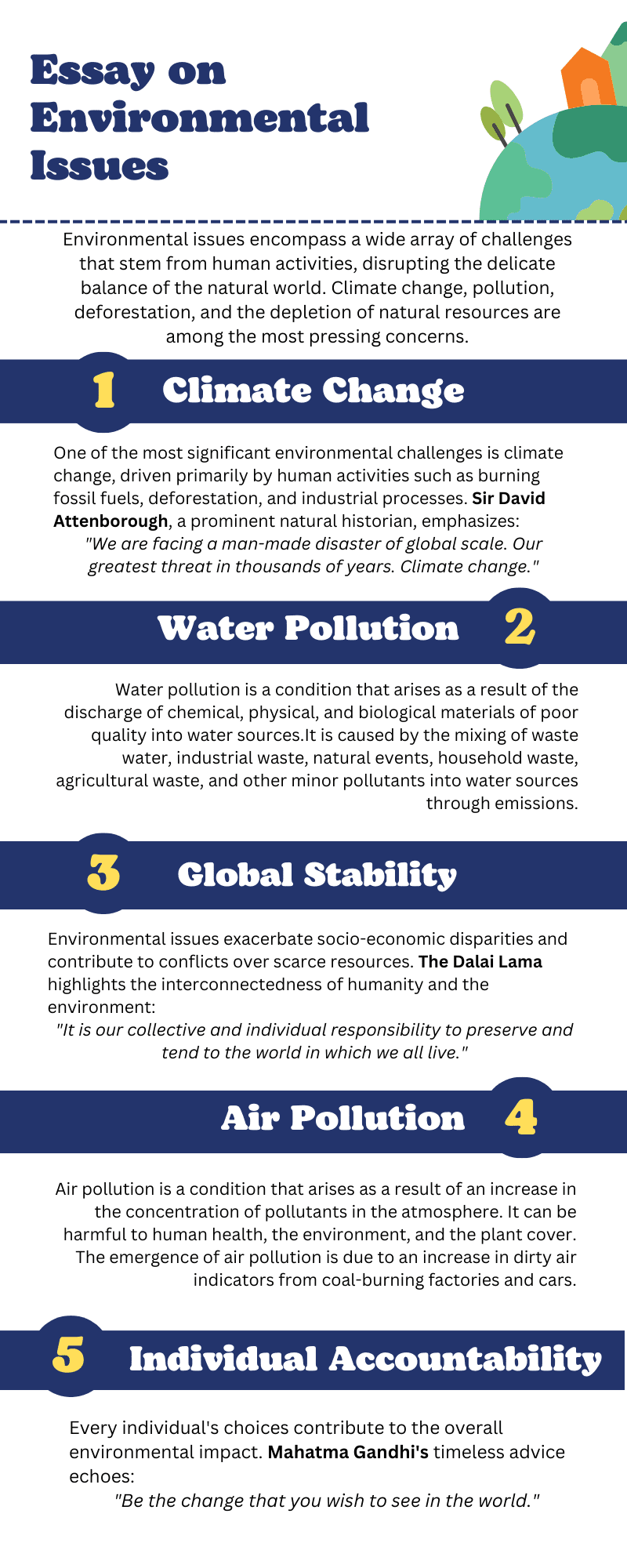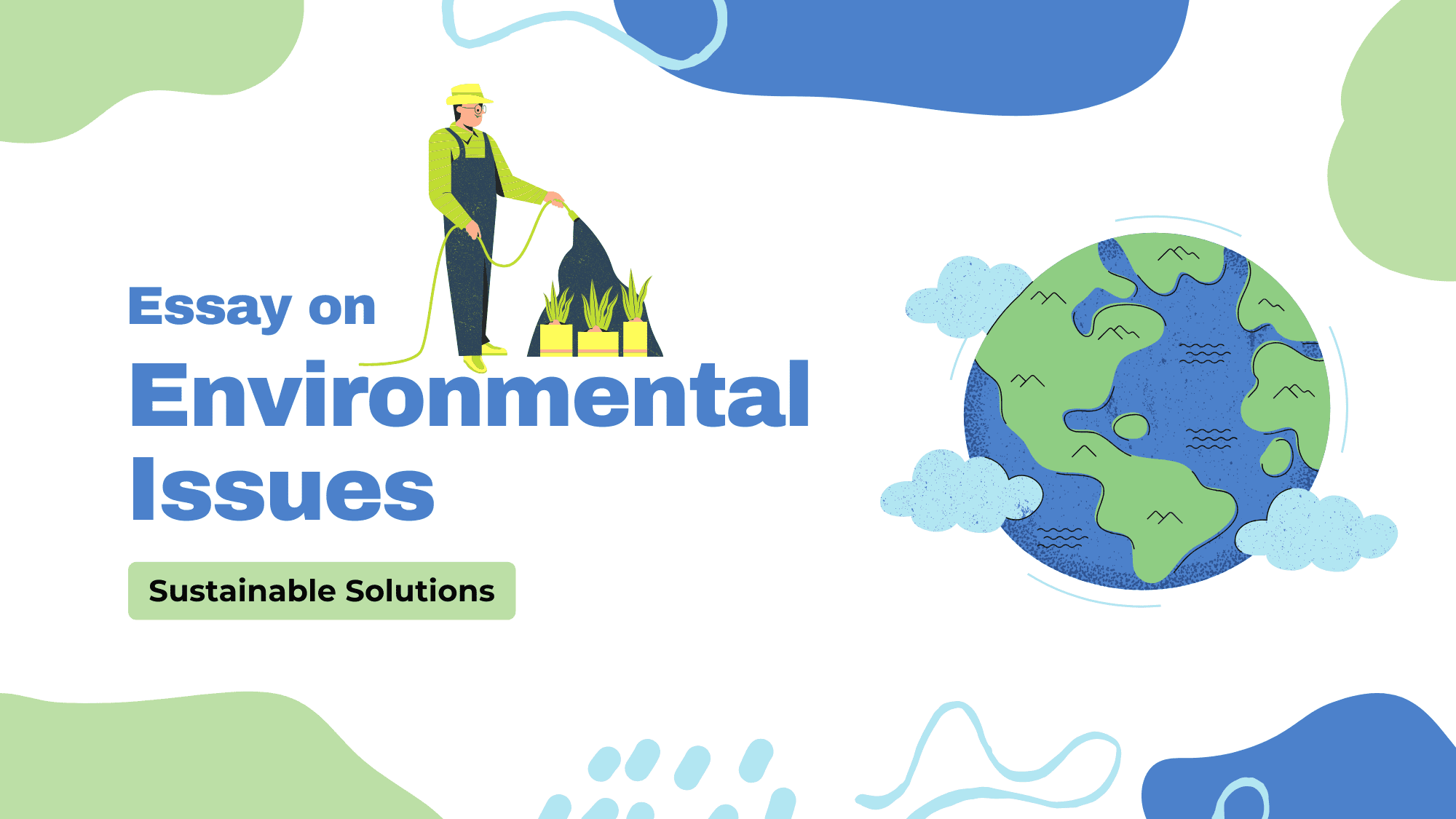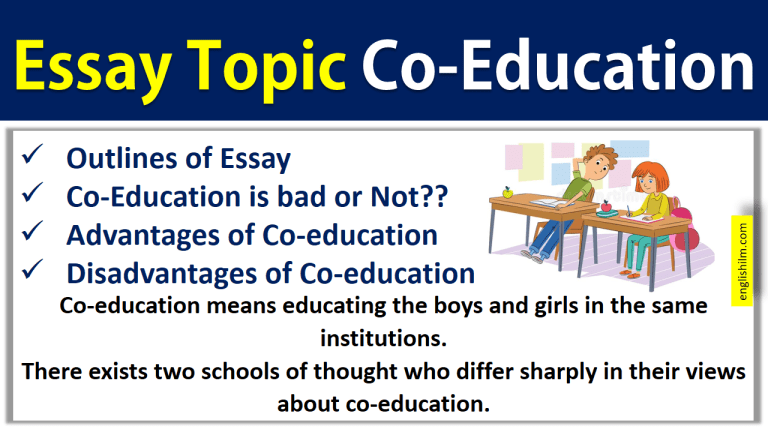The word essay is derived from the Latin word Exagium, which means translating one’s point of view. So, an essay is a short piece of writing describing one’s argumentation style, experiences, and stories.
Types of essay writing:
There are many types of essays; they may be argumentative, narrative, comparative, or expository. These are common at school and college level or in world business, but at this point, these may be called reports. To write a good essay, decide your topic wisely and engrave in a persuasive writing style.
Structure of an essay:
The structure of an essay mainly consists of three parts:
- Introduction
- Body or middle section
- Conclusion
Essay on Environmental Issues
Introduction:
Global environmental issues are now a major concern that need to be addressed immediately and with coordinated efforts due to their far-reaching effects. Numerous issues, from pollution and deforestation to climate change and biodiversity loss, threaten the delicate balance of our planet’s ecosystems. In order to protect our world for future generations, this essay examines viable, sustainable solutions to some of the most pressing environmental problems of our day.
Defining Environmental Issues
Environmental issues encompass a wide array of challenges that stem from human activities, disrupting the delicate balance of the natural world. Climate change, pollution, deforestation, and the depletion of natural resources are among the most pressing concerns. As Rachel Carson, the pioneer of environmental science, aptly stated:
“The more clearly we can focus our attention on the wonders and realities of the universe around us, the less taste we shall have for destruction.”
1. Climate Change:
One of the most significant environmental challenges is climate change, driven primarily by human activities such as burning fossil fuels, deforestation, and industrial processes. The rise in greenhouse gas emissions has led to global warming, resulting in erratic weather patterns, rising sea levels, and extreme weather events.
Sir David Attenborough, a prominent natural historian, emphasizes:
“We are facing a man-made disaster of global scale. Our greatest threat in thousands of years. Climate change.”
Solution: Transitioning to renewable energy sources, improving energy efficiency, and adopting sustainable practices can mitigate climate change. Governments and industries must collaborate to reduce carbon footprints and invest in green technologies.
2. Deforestation:
The relentless clearing of forests for agriculture, logging, and urbanization contributes to the loss of biodiversity, disrupts ecosystems, and intensifies climate change.
Wangari Maathai, the Nobel laureate, underscores the importance of trees:
“A tree is a little bit of the future.”
Solution: Sustainable forestry practices, afforestation initiatives, and promoting responsible consumer choices can help preserve and restore forests. Stricter regulations on logging and land-use planning are essential to curbing deforestation.
3. Pollution:
Air, water, and soil pollution pose serious threats to both the environment and human health. Industrial emissions, improper waste disposal, and the widespread use of harmful chemicals contribute to the degradation of ecosystems.
Mahatma Gandhi’s words resonate:
“Earth provides enough to satisfy every man’s needs, but not every man’s greed.”
Solution: Implementing stringent environmental regulations, promoting recycling and waste reduction, and adopting cleaner production methods are crucial steps. Public awareness campaigns can encourage responsible consumption and waste management.
4. Human Health
Air and water pollution, coupled with climate-related health risks, pose significant threats to human well-being. The World Health Organization warns:
“Climate change is the greatest threat to global health in the 21st century.”
5. Loss of Biodiversity:
The extinction of species at an alarming rate is a direct consequence of habitat destruction, pollution, climate change, and overexploitation of natural resources.
As Jane Goodall articulates,
“The least I can do is speak out for those who cannot speak for themselves.”
Solution: Conservation efforts, protected areas, and sustainable resource management are essential to preserving biodiversity. International cooperation is crucial to addressing the global nature of biodiversity loss.
6. Renewable Energy
Transitioning to renewable energy sources, such as solar and wind power, is pivotal to reducing carbon emissions. As Elon Musk envisions:
“We have this handy fusion reactor in the sky called the sun.”
7. Water Scarcity:
Growing populations, agricultural demands, and industrial activities strain freshwater resources, leading to water scarcity in many regions.
Solution: Efficient water management practices, investment in water-saving technologies, and conservation measures are vital. Developing and implementing policies to ensure equitable access to water can address social aspects of water scarcity.
8. Global Stability
Environmental issues exacerbate socio-economic disparities and contribute to conflicts over scarce resources. The Dalai Lama highlights the interconnectedness of humanity and the environment:
“It is our collective and individual responsibility to preserve and tend to the world in which we all live.”
9. Plastic Pollution:
The widespread use of single-use plastics has resulted in vast amounts of plastic pollution in oceans and terrestrial environments, harming marine life and ecosystems.
Solution: Reducing plastic consumption, promoting recycling, and developing biodegradable alternatives can mitigate plastic pollution. Stricter regulations on plastic production and disposal are necessary to curb the problem.
10. Sustainable Practices:
Adopting sustainable practices in agriculture, industry, and daily life is imperative. Albert Einstein’s wisdom rings true:
“We won’t solve problems by using the same kind of thinking we used when we created them.”
11. Global Cooperation:
Environmental issues transcend national boundaries, necessitating collaborative efforts on a global scale.
12. Individual Accountability:
Every individual’s choices contribute to the overall environmental impact. Mahatma Gandhi’s timeless advice echoes:
“Be the change that you wish to see in the world.”
Resolving environmental problems calls for a coordinated and aggressive strategy. To protect our world, communities, businesses, governments, and individuals all have important roles to play in putting into practice sustainable solutions. We have the power to build a more sustainable future for future generations by implementing ethical behavior, embracing environmentally friendly technologies, and encouraging a global commitment to environmental stewardship. Since inaction will have long-lasting and irreparable implications on our world, the moment to act is now.
You may also like:
- Essay Writing in English
- Complete Essay On Co-education In English
- Essay Writing On The Value of Computer
- Complete Essay On Democracy
- Internet Addiction In English With 1000+ Words
Essay on Environmental Issues | Image







